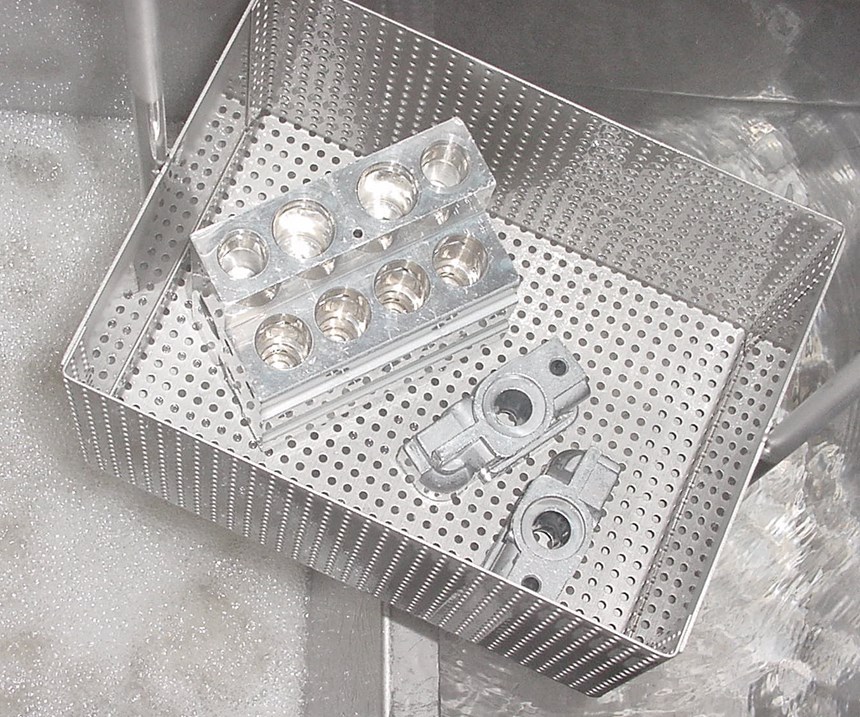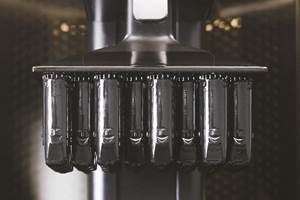How to Choose a Debinding Fluid for Metal 3D Printing
Binder jetting and feedstock extrusion depend on binders that are ultimately sacrificial. MicroCare offers factors to consider in selecting a debinding fluid for these metal additive manufacturing processes.
Metal 3D printing is a dynamic process capable of producing machine-grade metal parts. Ideal for producing parts with complex geometries, metal 3D printing can help maximize production by creating parts that would be too expensive or time-consuming to make using traditional machining methods like lathing or turning. Parts can be produced in hours instead of the days needed when using more conventional methods.
Two methods of metal 3D printing stand out in particular for their speed, ease of use and cost-effectiveness: binder jetting and feedstock extrusion.
Both processes use a combination of finely powdered metals and binders to form finished parts. Binder jetting creates green parts on a powder bed by depositing alternating layers of the metal powder and the binders to build the part. The feedstock extrusion method, on the other hand, starts with an admixture of the metal powder and the binders and creates the green parts by extruding the mixture along a precise path, layer-by-layer directly onto a build plate.
Metals available include stainless steel, tool steel, and many other ferrous and nonferrous alloys. Common types of binders contain paraffin wax, carnauba wax and specialty polyethylene waxes.
Debinding, or removal of the wax binders, is a balance of eliminating the binders in the shortest amount of time and with the least amount of damage.
In both processes, the binders serve a critical purpose in forming the metal powder into a specific shape. However, the binders are ultimately sacrificial and must be removed before the green parts can be exposed to the high heat required for the next step of sintering. Debinding, or removal of the wax binders, is a balance of eliminating the binders in the shortest amount of time and with the least amount of damage to the structure because as the binders are removed, the structure becomes fragile.
Once the wax binders are fully removed from the green parts, the parts are ready to be sintered. Any remaining binders in the parts are effectively burned off while the parts are compacted at near melting temperatures. The metal powder bonds together and the finished parts reach their solid mass state. After that, the sintered parts can be postprocessed using standard metal finishing techniques like grinding, cutting or coating.
Debinding is an important step in the ultimate success of both the binder jetting and the feedstock extrusion 3D printing processes. Typically, a specialty fluid that is engineered to selectively remove some (typically up to 4%), but not all, of the binders is used. The debinder fluid dissolves the binders and transports them out of the metal parts, creating pores and voids in the parts in preparation for the sintering furnace. The binders are progressively removed to avoid deformation and cracking during sintering, while also allowing the parts to maintain their dimensional accuracy, compress uniformly and sinter evenly. The debinding process typically allows for faster sintering times resulting in shorter production runs.
Selecting a Debinding Fluid
Fluid extraction of the binders can be easily done with a vapor degreaser. The debinding may be performed in either the vapor or liquid phase in the vapor degreaser, depending on the metals used and the binders to be removed. Both vapor degreasing phases rely on the fluid penetrating the parts to efficiently dissolve the wax from the full interior. This is where the physical properties of the debinding fluid become important and should be chosen carefully. Here are some factors to consider when selecting the debinding fluid:
Good materials compatibility: The debinding fluid should be safe to use on delicate uncured substrates. Use a fluid that is compatible with both the metal powders and the binders to safeguard the integrity of the formed parts.
Right solvency or strength: Fluid strengths are typically indicated by Kb values. The debinding fluid should be aggressive enough to selectively remove the right amount of binders yet still maintain the integrity of the parts. Too much binder left behind could result in cracking, deformation or part expansion during the sintering process.
Low toxicity: To protect workers and the environment, choose a fluid without n-propyl bromide, methyl pyrrolidone, heptane or trichloroethene which all carry health and/or environmental baggage.
Low boiling: Low boiling fluids still melt the wax and additives but allow the vapor degreaser to run more efficiently, saving energy costs. The low boiling point also prevents damage to the non-soluble binder components.
Fast evaporating: Fluids with low latent heat of evaporation dry more quickly, translating into greater product throughput.
Low surface tension: Low surface tension allows the fluid to work its way into the parts structure to penetrate the pores and internal channels to remove the binders more easily.
Low viscosity: Fluids with low viscosity flow around the parts more easily for more complete debinding and cleaning.
Nonflammability: Nonflammable fluids are safer for workers and do not require specialty fire or explosion-proof equipment.
Maintenance-free: Debinding fluids should be stable and not require acid acceptance testing or stabilizer maintenance.
Even state-of-the-art designs and manufacturing processes can benefit from unique chemistries that make these process advancements possible. It is essential to work with a critical cleaning partner that has specialized expertise in vapor degreasing and fluid debinding. Some fluid manufacturers have field engineers to conduct on-site audits to evaluate debinding methods. They may also perform comprehensive in-lab tests with sample parts to ensure cleaning and debinding success. They can recommend the debinding fluids and methods that will work best.
About the Author
Venesia Hurtubise
Venesia Hurtubise is a technical chemist at MicroCare which offers precision cleaning, coating and lubricating solutions. She has been in the industry more than 5 years and holds a MS in green chemistry from Imperial College London. Hurtubise researches, develops and tests cleaning-related products that are used on a daily basis in metal and precision cleaning applications. For more information, visit microcare.com.
Related Content
Understanding HP's Metal Jet: Beyond Part Geometry, Now It's About Modularity, Automation and Scale
Since introducing its metal binder jetting platform at IMTS in 2018, HP has made significant strides to commercialize the technology as a serial production solution. We got an early preview of the just-announced Metal Jet S100.
Read MoreHow Siemens Energy Applies Additive Manufacturing for Power Generation and More
At an applications center in Orlando, Florida, a small team of AM specialists is spanning industries by 3D printing parts to support both Siemens Energy power generation systems and external customers.
Read More10 Important Developments in Additive Manufacturing Seen at Formnext 2022 (Includes Video)
The leading trade show dedicated to the advance of industrial 3D printing returned to the scale and energy not seen since before the pandemic. More ceramics, fewer supports structures and finding opportunities in wavelengths — these are just some of the AM advances notable at the show this year.
Read MoreAM 101: Digital Light Synthesis (DLS)
Digital Light Synthesis (DLS) is the name for Carbon's resin-based 3D printing process. How it works and how it differs from stereolithography.
Read MoreRead Next
AM 101: What Is Binder Jetting? (Includes Video)
Binder jetting requires no support structures, is accurate and repeatable, and is said to eliminate dimensional distortion problems common in some high-heat 3D technologies. Here is a look at how binder jetting works and its benefits for additive manufacturing.
Read More3D Printing with Postprocessing in Mind
3D printing requires different finishing considerations than traditional manufacturing. One expert offers do’s and don’ts for approaching the finishing of additively manufactured parts.
Read More4 Ways the Education and Training Challenge Is Different for Additive Manufacturing
The advance of additive manufacturing means we need more professionals educated in AM technology.
Read More






















